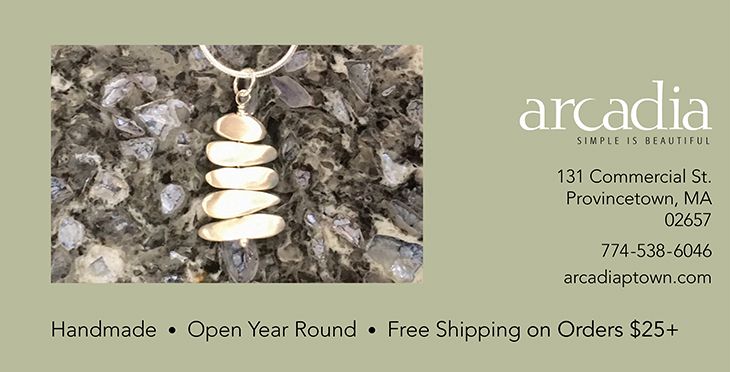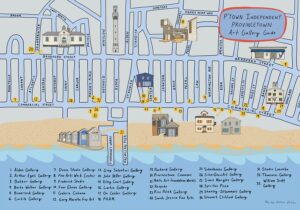
On Center Gallery (352 Commercial St.)
Nathaniel Meyer grew up in Maine near the Schoodic Peninsula of Acadia National Park. That’s where, as a child toting a French easel, he learned to paint. His landscapes, done with oil on canvas, are at On Center Gallery: splendidly saturated, mythical worlds populated by smooth stones, friendly trees, and crashing seas.
When he was a child, Meyer says, “We would take the world’s most rickety, leaky boat out into the Gulf of Maine,” he says. He’d explore the islands; each was a world of its own. “That’s a pretty tidy metaphor for painting in general, right?” he says. “Every piece is this whole world you’re establishing — with its own rules.”
His work has “plein air painting DNA” in it, he says, although he works in the studio. Newell’s Ledge II is based on a painting that has stuck in Meyer’s head for decades: Black Spruce Ledge by N.C. Wyeth. Both pieces show “the walling up of an island,” he says. “It’s almost like a collaboration with someone who has been dead for quite some time.”
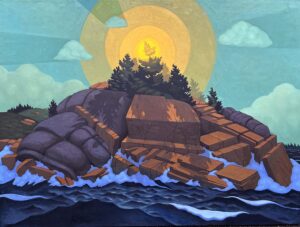
Meyer likes interacting with people on the gallery stroll. Often, people interpret his work differently than he imagined. “Sometimes I’m like, ‘That’s even better!’ ” he says. “Other times they’re like, ‘Have you noticed that these rocks look like a face?’ ”
William Scott Gallery (439 Commercial St.)
Lisa Weismann retired two weeks ago from a career as a medical oncologist. She splits her time between Watertown and Provincetown. Where else would she be on a Friday night in June but on Commercial Street, dipping in and out of the galleries? At William Scott, she’s interested in four paintings by Armando Pedroso: pastoral scenes made surreal by their odd coloring and a certain eerie stillness. “It’s not a typical pastoral scene,” she says, “and yet it’s a pastoral scene.” She’s struck by the clean lines of the barn — almost “midcentury modern,” she says, “but enlivened by the bold red, and then this ridiculous cow.” Well, at least she thinks it’s a cow. “It could be a sheep for all I know.”

Don’t get her wrong — Weismann loves to look at the ocean. “But it’s nice to see some artwork that is not about Provincetown landscapes,” she says. “There’s a pink tree behind a blue house with pink wheatfields. It’s not found in nature, and yet it is. It looks like you’d see it in Vermont — if you were on drugs.”
Rice Polak Gallery (430 Commercial St.)
“Honestly,” says Dave Zebny, “the minute I walked into the room, I loved the realism of the work.” He’s peering intently at The Colors From Her Dream at the Mary Heaton Vorse House by Nick Patten: a coolly sunlit scene, all glass and oiled tabletop, spare and bright. “I know the precision that it took the artist to really think and execute that,” he says. “I really appreciate the effort.” The piece reminds Zebny, who is from Washington, Conn. and New York City and works in real estate investment, of the Dutch masters, “who also perfected that realism.”
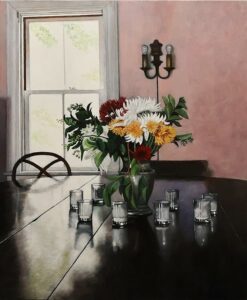
“When I look at a painting,” says Zebny, “I want to feel something.” This painting makes him feel like he’s at home. “I remember when I would go to my grandmother’s house and the table looked like that.”
Packard Gallery (418 Commercial St.)
Rhonda and Cameron Warren are boat people. Originally from Calgary, Alberta, they’ve been away from home for a while. They work on yachts — Rhonda is a first mate, and Cameron is a captain. They’re drawn to Anne Packard’s piece Quiet, a scene so placid it feels unreal. “I like the muted nature of it, and the peacefulness,” says Rhonda. “It’s very calming and soothing. It’s familiar in some way.”
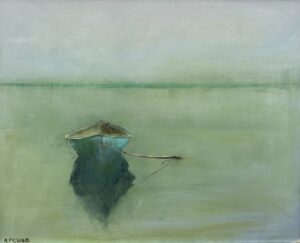
“Everyone is different,” says Cameron, “but for me, it’s about what you would want to wake up to in the morning.”
Rhonda calls the piece “dreamy.” Why? Cameron has a quick answer: because of that surreal green color. “It’s not blue.”
Greg Salvatori Gallery (366 Commercial St.)
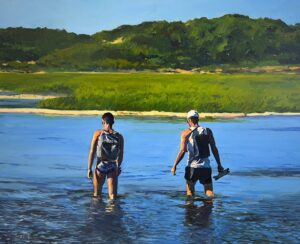
Su Frost is visiting from Burnsville, N.C., where she owns a bed and breakfast with her husband. She’s originally from Oxford, England — the cheerful accent remains. She loves Sun-Days by Michael Lyons, in which two men wade through shallow water, their skin glowing in the sun. “A lot of the time you see paintings and hands are too big, or feet are too big,” says Frost. “But this one, everything is in the right proportion.” She indicates the knees of one man, which churn the water around them. “You can tell that he’s moving forward through the water. It looks so real. It could be a photograph, but it isn’t.” Some people like abstract, she says. “I’m not an abstract person.”
Galeria Cubana (357 Commercial St.)
Bobby Douglas is from Atlanta and visits Provincetown every summer. He just finished eating some “fabulous” crab cakes. Now he’s spellbound by the work of Andrey Quintana at Galeria Cubana: large canvases painted edge to edge with dizzyingly colorful acrylic flowers.
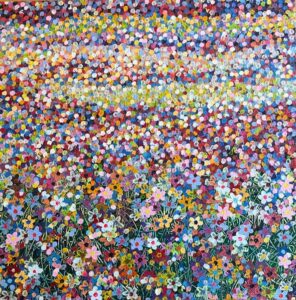
“I saw them from across the street,” says Douglas. “I was like, ‘How joyous!’ It warmed my heart.” Douglas works in logistics, he says. “Math all day.” Quintana’s flowers offer something simple: “Peace.” But, actually, not quite. Quintana painted every petal using a bullet casing, also on display on the wall of the gallery. “My assumption,” says Douglas, “is perhaps the artist is trying to convey something a little bit more important than beauty.”
But they’re still beautiful, he says. He backs up to view the paintings from a distance. “Look at them from this perspective. There are gorgeous flowers, a whole sea of flowers. Now get close. You lose it. It’s gone.”
